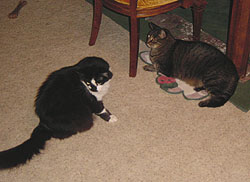|  The
term "aloof" means
a personality that is very independent.
In some degree this is desirable
since the opposite extreme results
in separations anxiety or other
behavior problems as a result
of too much bonding. The
term "aloof" means
a personality that is very independent.
In some degree this is desirable
since the opposite extreme results
in separations anxiety or other
behavior problems as a result
of too much bonding.
  On
the other hand, we humans like
a pet who likes us back. Some
pets seem to not know we exist,
and do not seek our company
or attention. Some of this is
simply their individual personality,
which means there is a large
genetic component. This pet
may never be as highly bonded
as you would like. On
the other hand, we humans like
a pet who likes us back. Some
pets seem to not know we exist,
and do not seek our company
or attention. Some of this is
simply their individual personality,
which means there is a large
genetic component. This pet
may never be as highly bonded
as you would like.
 Another
significant factor in bonding
vs. aloofness is that
personality is heavily influenced
by the pet's critical
socialization period. Another
significant factor in bonding
vs. aloofness is that
personality is heavily influenced
by the pet's critical
socialization period.
This is
the period in their youth, when
the brain was ready to develop
bonding with people. In the
cat this occurs between 3-7
weeks of age. In the dog is
happens from 4-12 weeks. If
the pet did not get sufficient
exposure, or worse, negative
exposure, this can result in
a personality later in life
that does not seek out companionship.
 This behavior
might be partially a ploy on
the part of the pet to
try to control the owner,
the home environment,
or both. This behavior
might be partially a ploy on
the part of the pet to
try to control the owner,
the home environment,
or both. |
 If
the pet has been punished, and
did not understand the circumstances
or reasons (e.g. punishment
after the fact) the pet might
see the owner as unreliable,
and therefore someone to be
avoided. A good rule is to never
punish the pet, instead
interrupt when caught in the
act, otherwise ignore and find a
way to prevent the problem the
next time. If
the pet has been punished, and
did not understand the circumstances
or reasons (e.g. punishment
after the fact) the pet might
see the owner as unreliable,
and therefore someone to be
avoided. A good rule is to never
punish the pet, instead
interrupt when caught in the
act, otherwise ignore and find a
way to prevent the problem the
next time.
Steps you can do to increase
your bonding with a pet
- Feed
meals instead of free choice,
so you are seen as the giver
of the food.
-
Hand feed the pet the first
several kibbles.
-
Don't let the pet see
you clean up the elimination.
-
Don't hold the pet against
its will with your hands,
even though you feel like
being close.
-
In dogs, begin "Close
Tethering" where you
tie the dog to your chair.
When first doing this, give
a chew toy, ignore fussing
(don't touch the dog)
and praise any relaxed posture.
-
If the pet does seek your
affection, give it gently.
Try to make it as positive
as possible.
-
Keep a air-tight jar with
some pet treats near where
you lounge. Periodically toss
one, gradually closer to entice
the pet closer or onto your
lap. Give one periodically
while acting in the way you
want.
-
Avoid any physical punishment
or any reason. Put the emphasis
on praising the positives.
-
Try to find toys that will
excite the pet
-
Consult with an experienced
pet behaviorist for more specific
advice.
|